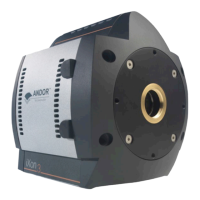Page 66
Hardware
4.3.1 - Thermoelectric cooler
TheiXon3rangemakesuseofafour-stage(seeNOTEbelow),Peltiercoolingassembly,whichutilizesthethermoelectric
effect to rapidly cool the sensor down to the stable operating temperature. TE coolers have a cold end (in contact with
the sensor) and a hot end. Heat must be efciently dissipated from the TE cooler for effective cooling of the sensor.
The iXon3 is expertly designed to yield maximum heat dissipation, via either forced air cooling (in-built fan) or water
cooling, which in combination with Andor’s UltraVacTM vacuum process, results in market-leading cooling performance.
A recirculator or a chiller can be purchased from Andor Technology to provide convenient and effective heat dissipation
through water cooling.
The iXon3 camera also contains temperature control components, which regulate the cooling of the camera and ensure
that a stable temperature is maintained between and throughout measurements.
NOTE: DV885 models have a three-stage peltier cooler; DU885 models have a four-stage peltier cooler.
4.4 - OUTGASSING
Outgassingisthereleaseofagastrappedinmaterial.Itisaproblemencounteredinhigh-vacuumapplications.
Materials not normally considered absorbent can release enough molecules to contaminate the vacuum and cause
damage to optical sensors, window coatings, etc.
Even metals and glasses can release gases from cracks or impurities, but sealants, lubricants, and adhesives are the
most common cause. Left unchecked, cooling performance would steadily degrade and therefore lead to increased dark
current. Furthermore, resulting electrochemical reactions would eventually destroy the sensor.
Figure 44: UltravacTM metal
hermetic vacuum sealing

